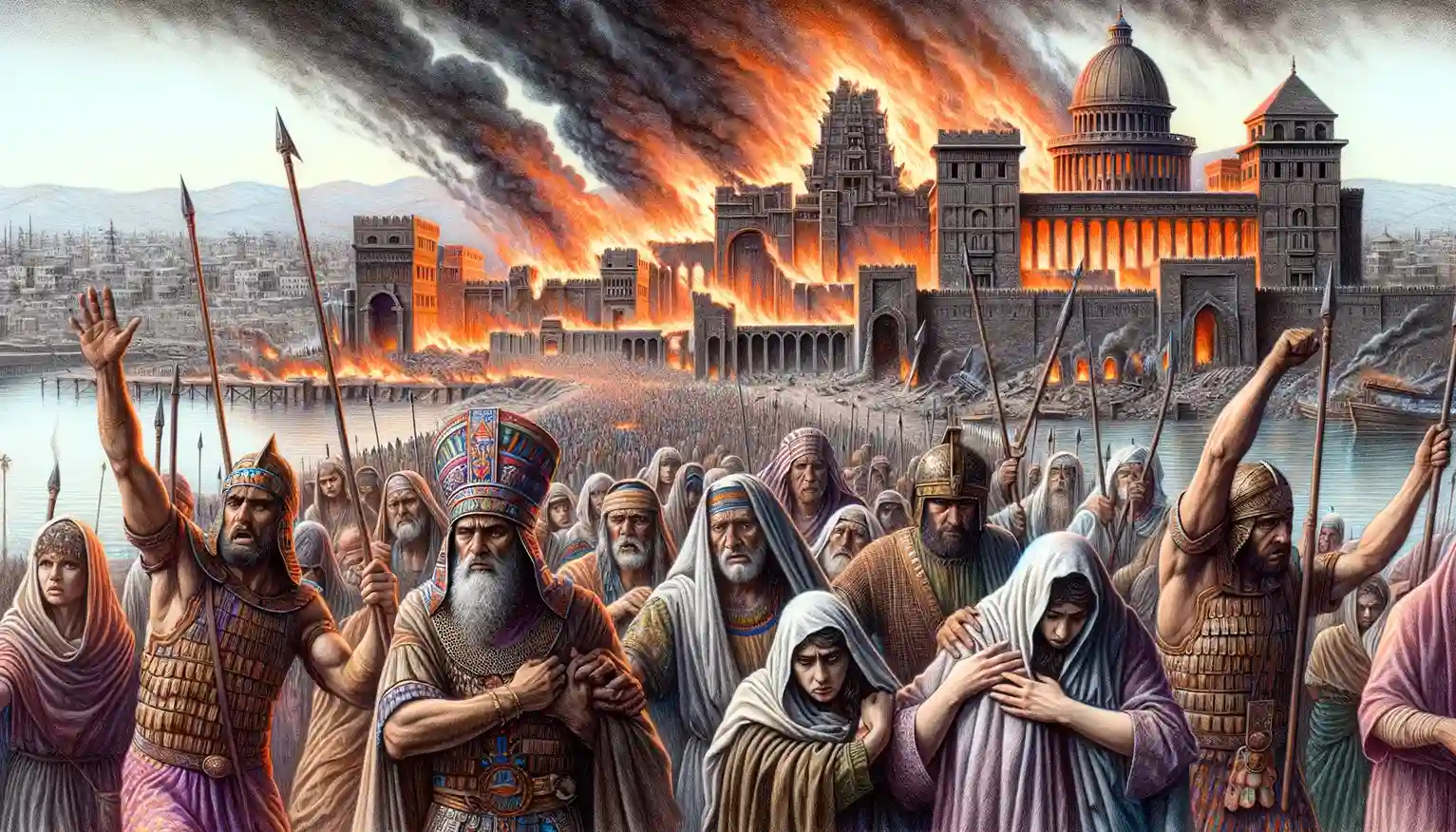
The Babylonian Captivity
Here are some quick facts about the Babylonian Captivity:
- Time Period: The Babylonian Captivity lasted from approximately 586 to 538 B.C.
- Cause: It was precipitated by the Babylonian conquest of Jerusalem.
- Key Event: The destruction of Solomon’s Temple in Jerusalem in 586 B.C. was a significant event during the captivity.
- Major Figure: Nebuchadnezzar II, the King of Babylon, was the driving force behind the conquest and captivity of the Judahites.
- Exile Impact: The captivity led to significant cultural, religious, and social changes among the Israelites, including the solidification of Jewish identity and religion.
- End of Captivity: The captivity ended when Cyrus the Great of Persia conquered Babylon and issued a decree allowing the exiles to return to Jerusalem and rebuild the Temple, leading to the period known as the Restoration.
- Literary Output: Significant portions of the Hebrew Bible, particularly the books of Lamentations and Ezekiel, were composed during or about the experiences of the captivity.
The Babylonian Captivity is recorded in several books of the Hebrew Bible, particularly in the historical and prophetic texts. Key references include:
- 2 Kings 24-25 – These chapters detail the sieges of Jerusalem by Nebuchadnezzar, the subsequent captivity of the Judeans, and the destruction of the city and the Temple.
- 2 Chronicles 36 – This chapter recounts the final siege of Jerusalem, the destruction of the Temple, and the exile of the people to Babylon.
- Jeremiah 52 – This provides another detailed account of the fall of Jerusalem and the captivity.
- Ezra 1-2 – These chapters describe the decree of Cyrus the Great that allowed the Jews to return to Jerusalem from Babylon and begin rebuilding the Temple.
- Nehemiah – This book focuses on the rebuilding efforts in Jerusalem after the return from exile, including the reconstruction of the city walls.
- Daniel – Although not directly describing the captivity, the Book of Daniel is set during the Babylonian Exile and provides insight into the lives and experiences of Jews living in Babylon during this period.
- Lamentations – This book, traditionally attributed to the prophet Jeremiah, poetically laments the destruction of Jerusalem and the suffering of its people, reflecting the trauma of the exile.
The Babylonian Captivity, also known as the Babylonian Exile, is a seminal period in Jewish history, marked by the deportation of a significant portion of the Judean population to Babylon following the destruction of Jerusalem and its temple in 586 B.C. This event is pivotal not only in the historical narrative of the Jewish people but also in the development of Jewish religious and cultural identity.
Historical Context
The Babylonian Captivity began after Babylon’s King Nebuchadnezzar II’s successful siege of Jerusalem in 586 B.C. This was not the first time Jerusalem had fallen to Babylon; there had been a series of conflicts and deportations beginning as early as 605 B.C. However, the 586 B.C. siege led to significant destruction, including the burning of the Temple, which was a central symbol of Jewish faith and identity.
Religious and Cultural Implications
The Exile had profound religious and theological implications for the Jewish people. It forced a transformation in the way they practiced their religion and thought about their relationship with Yahweh, their God. With the Temple destroyed and sacrifices no longer possible, the focus shifted towards Torah study and adherence to the Mosaic law, laying foundational aspects for modern Judaism.
Prophetic Responses
Prophets like Ezekiel and Jeremiah, who were active during and around the time of the Exile, provided a theological framework for understanding the disaster. Jeremiah, remaining in Jerusalem, preached a message of hope and restoration, insisting that the Exile was part of God’s plan for his people and that it would eventually lead to a new covenant. Ezekiel, among the exiles in Babylon, provided visions that reassured the displaced communities of God’s ongoing presence and the promise of return and restoration.
Literary and Theological Developments
The Exile also influenced significant literary and theological developments within the Biblical texts. Scholars suggest that much of the Hebrew Bible was edited and compiled during or shortly after the Exile. This period likely saw the final compositions of significant portions of the Old Testament, including parts of the Pentateuch and the historical narratives, as a means to preserve the history and laws of the Israelites.
End of the Captivity
The Exile ended in 538 B.C. when Cyrus the Great of Persia conquered Babylon and issued a decree allowing the Jewish exiles to return to Judea and rebuild the Temple, an event chronicled in the books of Ezra and Nehemiah. This return did not occur all at once but in waves, and not all exiles chose to return, with significant Jewish communities remaining in Babylon.
Lasting Impact
The Babylonian Captivity left a lasting impact on Jewish identity and religion. It was a crucible that forged many of the fundamental aspects of Judaism known today, including the centrality of the Torah, the shift away from temple sacrifices towards prayer and study, and the strengthening of the Jewish community bound not just by ethnicity but by a shared faith and practice.
The Babylonian Captivity is thus a cornerstone in Jewish history, embodying loss, adaptation, and renewal, and it continues to resonate as a powerful narrative of perseverance and faith within the Jewish tradition.



